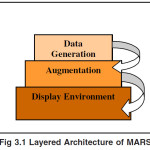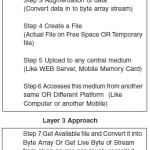Development and Implementation of Mobile Augmented Reality Systems Application (Live Streaming Through Mobile)
K.H. Wandra¹* and Ketan Kotecha²
¹CE Department, C. U. Shah College of Engineering and Technology, Wadhwan, (India).
²Institutes of Technology, Nirma University, Ahmedabad, (India).
Article Publishing History
Article Received on :
Article Accepted on :
Article Published :
Article Metrics
ABSTRACT:
These instructions give you guidelines for preparing papers for conferences or journals. Use this document as a template if you are using Microsoft Word. Otherwise, use this document as an instruction set. The electronic file of your paper will be formatted further at World Enformatika Society. Define all symbols used in the abstract. Do not cite references in the abstract. Do not delete the blank line immediately above the abstract; it sets the footnote at the bottom of this column. Page margins are 1,78 cm top and down; 1,65 cm left and right. Each column width is 8,89 cm and the separation between the columns is 0,51 cm.
KEYWORDS:
About four key words or phrases in alphabetical order; separated by commas
Copy the following to cite this article:
Wandra K. H, Kotecha K. Development and Implementation of Mobile Augmented Reality Systems Application (Live Streaming Through Mobile). Orient. J. Comp. Sci. and Technol;3(1)
|
Copy the following to cite this URL:
Wandra K. H, Kotecha K. Development and Implementation of Mobile Augmented Reality Systems Application (Live Streaming Through Mobile). Orient. J. Comp. Sci. and Technol;3(1). Available from: http://www.computerscijournal.org/?p=2230
|
Introduction
The recent convergence of the Internet and mobile radio has also accelerated the demand for “Internet in the pocket” on light, low-cost terminals, as well as for wireless technologies like GSM/GPRS[1][2], UMTS, Wi-Fi and WiBro that boost data throughput and reduce cost per bit. Mobile networks are now going multimedia, potentially leading to an explosion in throughput from a few bytes for the Short Message Service (SMS) to a few Kbits/s for the Multimedia Messaging Service (MMS), to several 100 Kbits/s for video content. Video has been an important media for communications and entertainment for many decades. Initially video was captured and transmitted in analog form. The advent of digital integrated circuits and computers led to the digitization of video, and digital video enabled a revolution in the compression and communication of video. Video compression became an important area of research in the late 1980’s and 1990’s and enabled a variety of applications including video storage on DVD’s and Video-CD’s, video broadcast over digital cable, satellite and terrestrial (over-the-air).Digital television (DTV), and video conferencing and videophone over circuit-switched networks. The growth and popularity of the Internet in the mid-1990’s motivated video communication over best-effort packet networks. Video over best-effort packet networks is complicated by a number of factors including unknown and time-varying bandwidth, delay, and losses, as well as many additional issues such as how to fairly share the network resources amongst many flows and how to efficiently perform one-to-many communication for popular content. The Mobile AR[3] System can be defined as; “A mobile AR system is one in which augmentation of the data occurs through available knowledge of where the user is (the user’s location and therefore the surrounding environment)”. In the present study, we have described that how to develop an algorithm based on our designed Layered Architecture for MARS and implementation for MARS Application (Live streaming through Mobile) on mobile platform. Here we capture live stream through mobile ,augment it and uploading to web server and from web server any mobile or computer users can see live video streaming on their devices. To implement MARS Application (Live streaming through Mobile) on mobile platform we have used J2ME library: MIDP, (CLDC), Net Beans 5.5.1 and 6.8 and Mobile SDK
Architecture of mars
The Layered Approach : The architecture of MARS can be depicted in many ways .There can be no restriction on which of the basic unit lies at which end. But broadly based on the functional requirement the we propose following MARS can have following layer model modules. Although it is not mandatory that each MARS should have strict distinction among this layers we propose this approach since distinct layers can be studied and explores independently to enhance the capabilities of the MARS.
A prominent example that served cause us to study the role of wireless technology issues in MARS is Columbia’s “Touring Machine”, which is used as a mobile multimedia information system[3] and journalistic tool[4]
Features of MARS: A mobile AR system combines the following features:
•Application and data sharing between a mobile and a stationary user or two mobile users[5]
•3D stereographic display of computer generated images. This enhances the sensation of seeing virtual objects.
•Direct manipulation and interaction with the virtual objects.
•Instant collaboration with another user wearing another mobile kit.
Operation of MARS: In the architecture that we have proposed the data generation module tracks the position of the scene/object using various tracking devices, it also involves human operator to enter the data using sophisticated devices such as touch pad, graphic tablet gloves and sensor. Then the recorded data is temporarily stored in the buffer and forwarded to augmentation Unit. In case of the mixed Reality Systems This unit may be responsible to mix the virtual and augmented environment. The mobile computing device within the Data generation Unit then Sends the data to the augmentation unit (In case if the Augmentation Unit is not within the data generation unit itself) which after augmentation Send the data to the display unit (again if it is different from other two units).Each layer communicates with the layer down using wired Connection Or Wireless connection
Wired Connection: Generally when the two layers do not have strict distinction at that time such connections can be used. For example in case of the situated documentaries as shown in Figure the augmentation unit may be within the Data generation unit.
Wireless Connection: But wired connection is not wise approach in the sensitive application like ones in the battlefield where the data generation unit (The soldier carrying Data Tracking Mobile devices) should be loaded with minimum weight and even the units can be hidden easily. So in such applications there is a strict distinction in all the layers described above. So each layer communicates with each other via different wireless technology.
An Algorithm for implementing mobile augmentation reality system (mars) real time application
Here authors have developed below algorithm to implement Mobile Augmented Reality System Application thorough mobile we can send or receive live data (Images. Audio and Video)
Tools used for implementation of mars application algorithm
Java Platform, Micro Edition (Java ME) was formerly known as Java 2 Platform, Micro Edition (J2ME)[6]. is a collection of technologies and specifications to create a platform that fits the requirements for mobile devices such as consumer products, embedded devices, and advanced mobile devices. It provides a robust, flexible environment for applications running on mobile and other embedded devices—mobile phones, personal digital assistants (PDAs), Java ME includes flexible user interfaces, robust security, built-in network protocols, and support for networked and offline applications that can be downloaded dynamically.
Java ME devices implement a profile. The most common of these are the Mobile Information Device Profile(MIDP)[7] aimed at mobile devices, such as cell phones, and the Personal Profile aimed at consumer products and embedded devices like set-top boxes and PDAs. Profiles are subsets of conFigureurations, of which there are currently two: the Connected Limited Device ConFigureuration (CLDC)[8] and the Connected Device ConFigureuration (CDC).
Java ME SDK 3.0
J2me library: MIDP, (CLDC)
Net Beans 5.5.1 & 6.8[9]
Conclusion
The growth and popularity of the Internet motivated video communication over best-effort packet networks. Video over best-effort packet networks is complicated by a number of factors including unknown and time-varying bandwidth, delay, and losses, as well as many additional issues such as how to fairly share the network resources amongst many flows and how to efficiently perform one-to-many communication for popular content.
A mobile AR system In this paper Author’s have described that how to develop an algorithm based on our designed Layered Architecture for MARS and implementation for MARS Application (Live streaming through Mobile) on mobile platform. We have used java platform so ,It can run on any Java enable mobiles, there are many more platforms are available author’s have given direction to do research in same direction. MARS no doubt along with the recent advancement in wireless technology change the way we look at the virtual as well at the real. Still we need to develop the software that can reflect the rapid change in the wireless technology and can handle the multimedia application in real time environment Authors are doing research to achieve higher data rates and how on mobile devices we can do Augmentation even batter .
References
- “The GSM System for Mobile communications”, Michel Mouly and Marie-Bernadette Pautet.
- 3GPP TS 23.060: “General Packet Radio Service (GPRS); Service description; Stage 2″.
- Augmented reality : an application for architecture By Anish Tripathi A Thesis Presented to the ,faculty of the school of architecture university of southern california in partial fulfillment of the requirements for the degree master of building science (building science)
- S. Feiner, B. MacIntyre, T. H¨ollerer, and A.Webster. A ouringmachine: Prototyping 3D mobile augmented reality systems for exploring the urban enviroment. In Proc. ISWC’97, pages 74–81, Cambridge, MA, USA, October 13–14 1997.
- T. H¨ollerer and J. Pavlik. Situated documentaries: Embedding multimedia presentations in the real world. In Proc.ISWC’99, pages 79–86, San Francisco, CA, USA, October 18–19 1999.
- http://java.sun.com/products/sjwtoolkit/
- http://java.sun.com/products/midp
- www.developers.sun.com/mobility/getstart/ articles/…/wirelessdev.pdf
- www.netbeans.org

This work is licensed under a Creative Commons Attribution 4.0 International License.


